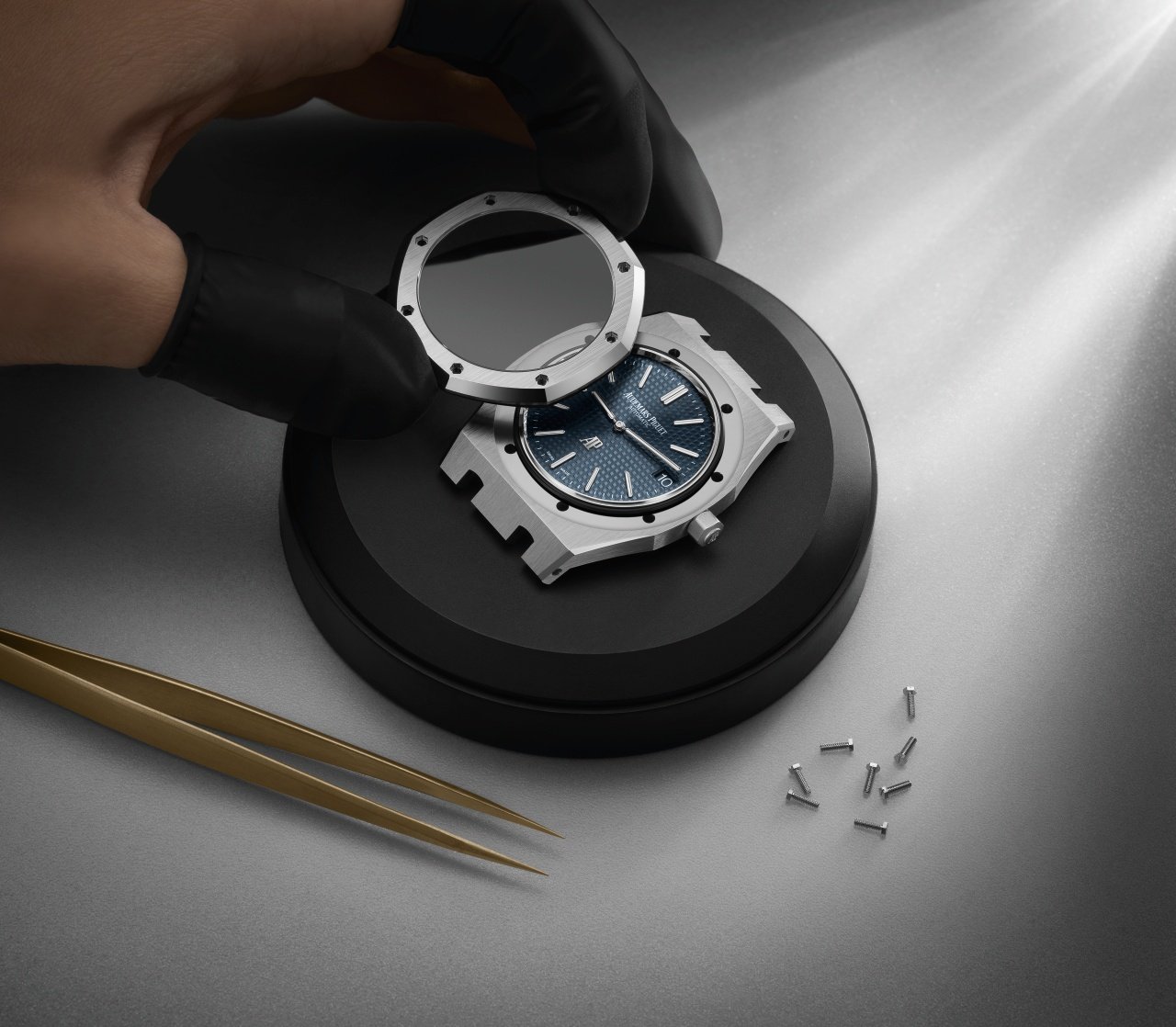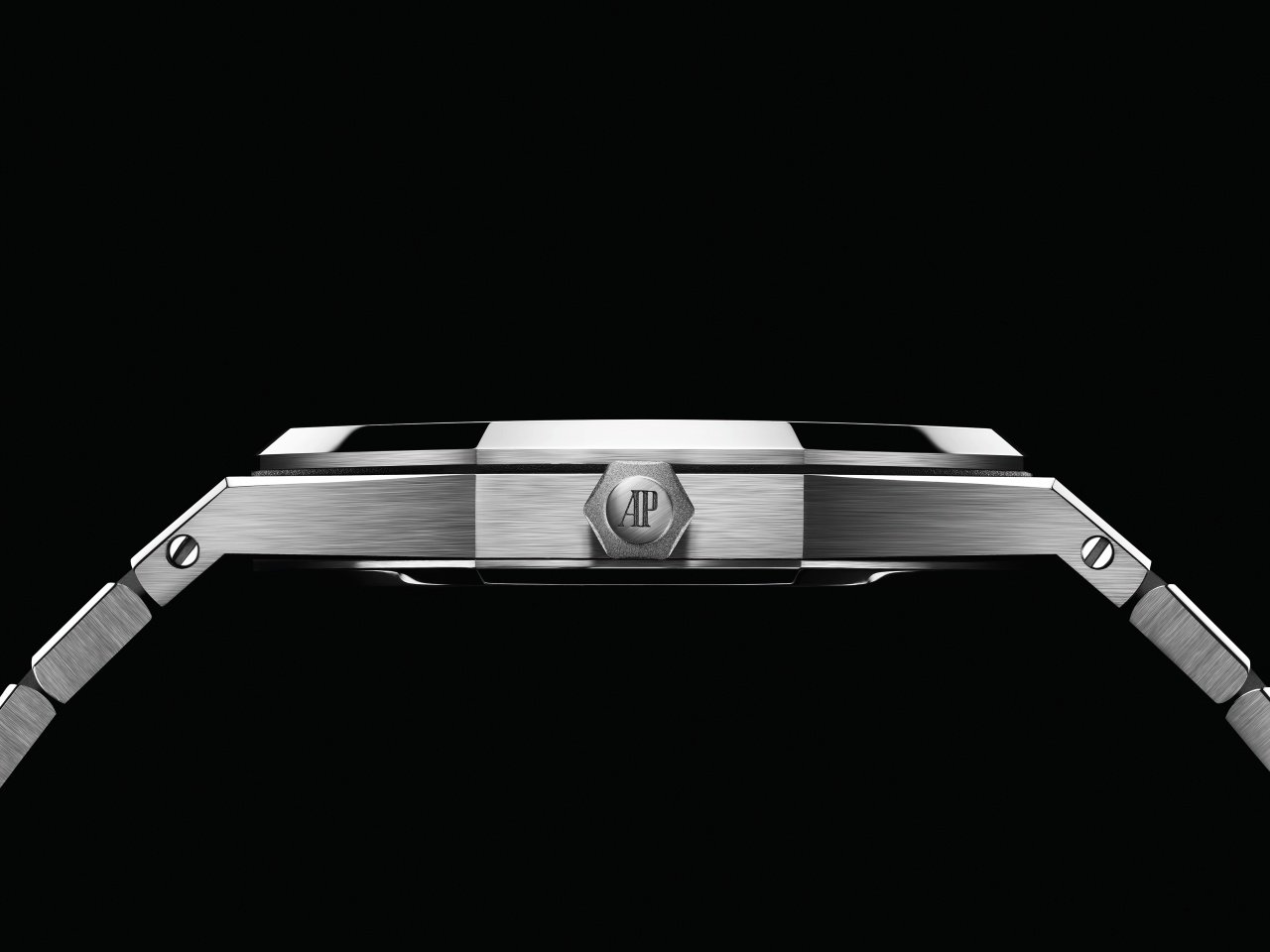o celebrate the Royal Oak’s 50th anniversary, Audemars Piguet has introduced the newest generation of 39 mm Royal Oak “Jumbo” Extra-Thin (ref. 16202), which houses the Manufacture’s new selfwinding extra-thin movement, Calibre 7121.
The collection comprises four models in stainless steel, platinum, as well as 18-carat pink and yellow gold-materials that have played an instrumental role in transforming the Royal Oak into an iconic collection. The four timepieces are also fitted with the dedicated Royal Oak’s “50 years” oscillating weight matched to the hue of the case.
For the first time since 1972, the Royal Oak “Jumbo” Extra-Thin welcomes a new self-winding hour, minute and date movement, Calibre 7121, which marks the debut of the new “Jumbo” reference 16202. This mechanism replaces Calibre 2121, the thinnest automatic movement with central rotor and date indication of its time (3.05 mm) first introduced on the Royal Oak in 1972, which retired at the end of 2021. The new movement, which measures 3.2 mm in thickness, has been specifically conceived and produced by Audemars Piguet engineers and watchmakers to fit in the extra-thin 8.1 mm “Jumbo” case without altering its aesthetic and thickness. Furthermore, the driving stem is now endowed with a rapid date-corrector.

Five years of development were necessary for the realisation of the new Calibre 7121, which is endowed with more energy than its predecessor thanks to its new construction. Its larger barrel confers it more power, making it more precise for a longer period of time. It is also equipped with a contemporary central oscillating weight mounted on ball bearings that utilises two reversers developed in-house to ensure bidirectional winding. Its balance wheel is fitted with inertia blocks that have been directly inserted within the balance wheel to avoid unnecessary friction. In addition, Calibre 7121 is equipped with a patented extra-thin low-energy date-setting mechanism.
Upholding fine watchmaking tradition, Calibre 7121 has been finished with refined Haute Horlogerie decorations such as “Côtes de Genève,” “traits tirés” and circular graining that can be admired through the watch’s sapphire caseback.
“Calibre 7121 has been constructed with the expertise of our engineers and watchmakers, specialised in both simple and complicated mechanisms. This cross-department collaboration resulted in the creation of a robust and powerful extra-thin selfwinding movement that seamlessly fits in the slender architecture of the Royal Oak “Jumbo” case, paving the way for a new generation of in-house AP movements,” said Lucas Raggi, Research & Development Director.

The new Royal Oak “Jumbo” Extra-Thin timepieces are fitted with the dedicated anniversary openworked oscillating weight in 22-carat gold, which features the “50 years” logo and the engraved Audemars Piguet signature. For the occasion, the oscillating weight has been matched to the colour of each case – a practice usually reserved to complicated timepieces. Similarly to the case, the oscillating weight has been finished with an alternation of satin-finishing and polished chamfers.
The “50 years” oscillating weight will be fitted to the Royal Oak anniversary models throughout 2022.
The stainless steel “Jumbo” version has retained the aesthetics of the original Royal Oak from 1972. The steel case and bracelet, hand finished with satin-brushing and polished chamfers, are complemented with the watch’s iconic Petite Tapisserie dial and Bleu Nuit, Nuage 50 (“night blue, cloud 50”) hue.
The dial’s Bleu Nuit, Nuage 50 colour was originally developed by Geneva-based dial maker Stern Frères. The blue hue was obtained by immersing each dial in a galvanic bath. While the formulation of the mixture is important, the duration and temperature are both crucial. If the artisan removes the dial too early, it comes out purple, if removed too late it turns black. A thin layer of varnish mixed with a few drops of black colour (n° 50) was then applied onto the dial to protect it. The term “nuage” refers to the cloud effect the drop of black creates when it enters the protective liquid varnish. Today, the Bleu Nuit, Nuage 50 hue is achieved internally through PVD (Physical Vapor Deposition) to ensure a more homogeneous colour across the collection.
Similarly to the Royal Oak from 1972, this new “Jumbo” model has kept the original baignoire or “bathtub”-shaped hour-markers and hands, which enable the luminescent material to be poured in for optimum legibility. The dial has also retained the polished gold applied AP monogram at 6 o’clock, as well as the printed “Audemars Piguet Automatic” mention at 12 o’clock. The “SWISS MADE” indication, which came to replace “SWISS” around the mid-1980s, remains positioned at 6 o’clock, with the words SWISS and MADE on either side of the hour-marker to balance the dial.
Yet, contrary to the original model, the sapphire caseback grants view of the new extra-thin movement and the dedicated anniversary oscillating weight, here in rhodium-toned 22-carat pink gold to echo the colour of the watch’s steel case and bracelet.

The new “Jumbo” collection includes a pink gold and a yellow gold model, both enhanced with the trademark Petite Tapisserie dial in new smoked shades. The 18-carat pink gold model is contrasted with smoked grey hues, while the 18-carat yellow gold version is illuminated with smoked yellow-gold tones. The two dials’ colours have been obtained through galvanic bath. The smoked effect, which has been achieved by meticulously spraying coloured varnish onto the rotating dial’s periphery, furthers the Tapisserie’s shimmering moiré effect.
The Petite Tapisserie pattern is achieved through a complex manufacturing process based on a rare know-how no longer taught in horology school. It consists of hundreds of small truncated pyramids with square bases carved out on the dial’s thin metal plate by an old guilloché copying machine that reproduces the motif of a matrix. Tens of thousands of diamond shapes, whose four inner faces reflect the light, are simultaneously cut out in the thin grooves separating the squares in a seamless weave that creates a tapestry appearance. This process requires extreme dexterity and precision.
The Petite Tapisserie of the original Royal Oak was first created and produced by Stern Frères, which ceased its activities in 2016. Meanwhile, after acquiring old guilloché copying machines, Audemars Piguet started to develop the craft and techniques internally. In 2010, the first in-house Petite Tapisserie dials came out of the Manufacture’s new dedicated workshop. Today, the guilloché dials of the “Jumbo” models are entirely produced in this atelier.
The two new timepieces are complemented with matching gold hour-markers, Royal Oak hands and AP monogram – all endowed with the original Royal Oak’s aesthetics. In addition, the corresponding 22-carat pink or yellow gold anniversary oscillating weight can be admired through the sapphire caseback.
The first Royal Oak entirely honed from yellow gold was introduced in the collection in 1977 on the women’s Royal Oak (ref. 8638) to respond to markets’ increasing demand. Both the Royal Oak “Jumbo” (ref. 5402BA) and the so-called “Royal Oak III” in 35 mm (ref. 4100BA) also welcomed a yellow gold version a few months later. Less common at the time, pink gold appeared in the Royal Oak collection in the mid-1980s, before joining the “Jumbo” line in 2006, with reference 15202. Both precious materials are today well established across the Royal Oak collection.
TECHNICAL SPECIFICATIONS
Functions
- Hours, minutes and date.
Case
- Stainless steel case, glareproofed sapphire crystal and caseback, water-resistant to 50 m.
- Case thickness: 8.1 mm
Dial
- “Bleu Nuit, Nuage 50” dial with “Petite Tapisserie” pattern, white gold applied hour-markers and Royal Oak hands with luminescent coating.
Bracelet
- Stainless steel bracelet with AP folding clasp.
Movement specification
- Selfwinding Calibre 7121
- Total diameter 29.6 mm (12 ¾ lignes)
- Total thickness 3.2 mm
- Number of jewels 33
- Number of parts 268
- Minimum power reserve guaranteed 55 h
- Frequency of balance wheel 4 Hz (28,800 vibrations/hour)







